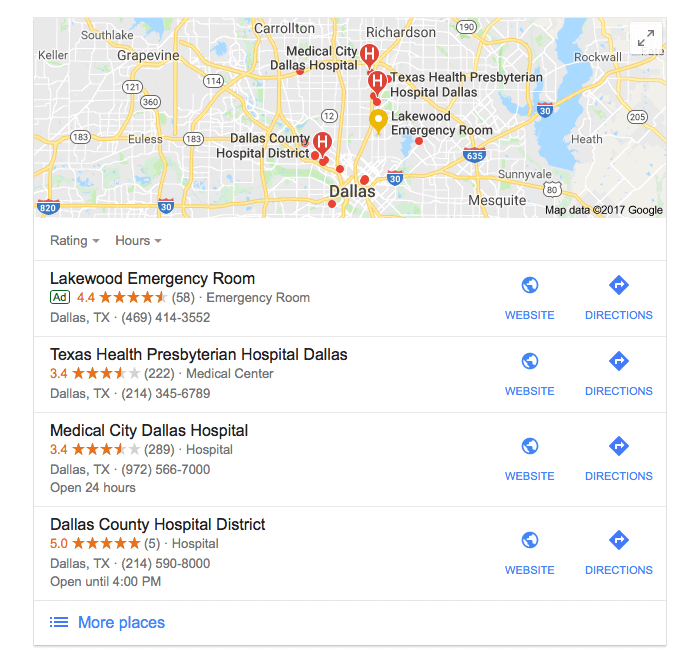If you were looking for a plumber, a place for a manicure, or a new restaurant recommendation, chances are you’d end up reading online reviews. Online reviews via Yelp, Facebook, and even Google are hugely popular—97% of people surveyed in a recent BrightLocal study read online reviews in 2017.
Finding a new dentist or healthcare provider is no different. Patients look to online reviews to learn more about you as a healthcare provider and your practice. Positive online reviews and personal recommendations influence almost 90% of people who search online. Due to their popularity and authority with search users, reviews have a lot of power when it comes to increasing your local search engine rankings.

Photo by henry perks on Unsplash
The Importance of Online Reviews for Healthcare Providers
You may not think your reviews online matter because you know that you’re a great doctor or that your practice has some of the best specialists in your region, if not the nation.
 All of those thoughts are true, but patients will still believe a review that says, “My doctor is fantastic, but the billing department is the worst to work with,” or “Dr. Smith kept me waiting, spent 5 minutes with me and wouldn’t listen to what I had to say.” You need positive reviews to help overcome these types of reviews that will get placed on your sites.
All of those thoughts are true, but patients will still believe a review that says, “My doctor is fantastic, but the billing department is the worst to work with,” or “Dr. Smith kept me waiting, spent 5 minutes with me and wouldn’t listen to what I had to say.” You need positive reviews to help overcome these types of reviews that will get placed on your sites.
You may also be concerned about why and how online reviews play into your local search rankings. Particularly if, like many practices, you are worried about negative reviews or privacy issues. Unfortunately, these problems cause many providers to ignore reviews altogether, which can cripple their local SEO plan.
A Pricewaterhouse Cooper survey revealed that 42% of individuals viewing health information on social media look at health-related consumer reviews and referrals of specific treatments or physicians.
Patients don’t leave your practice because they get bad medical care. They often leave because they don’t feel cared about or weren’t treated well by the staff, and 30% leave because of service. Those are the topics that show up in reviews, and if 80% of your patients are satisfied, you need them to leave reviews too.
A recent report from the Altarum Institute Center for Consumer Choice in Health Care says, “43% of consumers said that they would be likely to switch doctors due to negative online ratings from other consumers, while only 23% of doctors thought that that would influence consumers.”
The fact is, you should be using review sites and soliciting reviews despite perceived privacy issues and negative reviews because your potential patients want this information.
Google uses many different factors to determine rankings for search queries, including things like the physical address of your practice, consistency, and number of mentions across the web, and reviews. Of these factors Google uses for local search, reviews are one of those significant factors. The bottom line on Google’s search business is driven by providing users the best search results possible for any given query, and reviews are a quick and easy way for them to establish many things about a practice:
- It is a real place that serves patients.
- Many good reviews indicate it is well-liked.
- Frequently added reviews can indicate a popular practice.
With reviews, Google’s general stance is that frequent, good reviews indicate a better result compared to practices that don’t have any or only negative reviews. Whether these practices are better in the real world or not is irrelevant in Google rankings without the data (i.e., reviews) to back it up.

While Google’s primary source of reviews is their own platform, Google’s reviews aren’t the only game in town, and they know this. Other important sites to consider are popular reviews sites —like Yelp, Yellowpages, and Healthgrades—and social media sites—like Facebook. Not only might Google pull reviews from these other sites to determine your rankings, but also the sites often have their own committed user base, who know and love these sites and will be likely to use them when they are looking for a healthcare provider. The more consistent listings and quality reviews you have, the better your local SEO, and using multiple review sites is a great way to boost your numbers.
Online Reputation Building For Your Medical Practice
The key to online success in 2018 for any small business, especially healthcare businesses, is building your reputation online and establishing your credibility. Reputation management online is based on creating consistent and thorough listings on directories, review sites, and other local listing sites. Some of the key components of a successful reputation management campaign include:
- Consistent information across your listings—your name, address, and phone number should be the same.
- Thorough listings—don’t just claim your listing and leave it there. Add images, list your hours, add as much information as you can.
- Reviews—once you’ve established your listings, reviews will become an important differentiator between your listing and the others.
Reviews Power Local SEO
One of the persistent concerns with reviews is what to do about negative reviews. If you’re trying your best to serve your patients, you shouldn’t worry about negative reviews. Review sites provide some mechanism to allow you to tell your side of the story on every review. Within the realm of reputation management, both positive and negative reviews are important.
Think about your patients. Do you think any of them would walk through the door if they couldn’t find a single person who had anything good to say about you or your practice? The net effect of having no reviews or only negative reviews is less credibility and lower rankings.
![]() Positive online reviews and personal recommendations influence almost 90% of people who search online. More reviews and higher ratings indicate credibility to search engines like Google, Bing, or Yelp and will get further up. Meanwhile, no ratings or predominantly negative ratings will push you down the listing. Eventually, you’ll make it so far down the list that you’ve effectively been wiped out from the list.
Positive online reviews and personal recommendations influence almost 90% of people who search online. More reviews and higher ratings indicate credibility to search engines like Google, Bing, or Yelp and will get further up. Meanwhile, no ratings or predominantly negative ratings will push you down the listing. Eventually, you’ll make it so far down the list that you’ve effectively been wiped out from the list.
Getting Positive Reviews
How do businesses go about getting positive reviews? In most cases, it’s as simple as asking. According to BrightLocal’s Local Consumer Review Survey, some 68% of respondents left a review after a local business asked them to. More telling, 74% indicated they had been asked by a business to leave a review. Next time you’re thinking about getting more reviews, consider the following:
- Getting reviews should be a continuous effort. Simply requesting reviews one time may get you a sizeable batch of positive reviews. Still, eventually, your influx of reviews will look stale, or your competitors’ reviews will start to outnumber yours. Either way, search engines audit ratings and reviews every so often to make sure the most current reviews are bubbling to the top. Simply put, a slow and consistent review gathering process that takes place over the course of a year can easily win over a single-day hustle for reviews.
- Some sites don’t want you to ask for reviews. For example, Yelp’s content guidelines offer the following:
Don’t ask for reviews and don’t offer to pay for them either: Please don’t ask your customers to review your business on Yelp. Over time, solicited reviews create bias on your business page — a bias that savvy consumers can smell from a mile away. Learn why you shouldn’t ask for reviews. You should also never offer compensation (discounts and freebies count too) in exchange for reviews.
Other sites, like Google, have different guidelines and may be perfectly fine with or even encourage asking patients to post a review. Understand the terms and conditions and editorial guidelines for the sites you are using to make sure you don’t run afoul of their editorial teams.
- Don’t forget your own website. There are many ways to use your own site to encourage and capture reviews from your patients. You can create integrations with leading review platforms to push patients out to your profiles to complete their reviews.
- Make sure you’re using industry-related review sites. Sites like Healthgrades, Vitals, RateMDs, and others are specifically targeted toward reviews of healthcare-related businesses and healthcare providers. These sites will have spent the time and energy providing patients with the kind of information they want when searching for a doctor or other healthcare business, which is an important contextual signal to search engines and search users alike.
- Consider your email signatures, invoices, and other forms of communication with patients. Do they have a place where you can solicit feedback? Simply adding “Give feedback” or “review us” with a link can be enough to encourage regular patient reviews.
- Do you blog? Put together a post about writing a review on Healthgrades or Google. Do you send an email newsletter? Send an email about how to give feedback and encourage patients to review you.
How to Handle Negative Reviews
What about negative reviews? As we have previously mentioned, negative reviews are a persistent concern, but they aren’t as world-ending as they seem. While it is a commonly held belief that unhappy customers are often the loudest, 63% of respondents in BrightLocal’s study had written positive reviews for local businesses compared to only 32% who’d left negative reviews. This suggests that online reviews tend to be predominantly positive.
In any case, how you handle a negative review is more important than whether every review is positive. If you find yourself facing a negative review, consider the following:
- Do not take it personally. While there are certainly outliers, most negative reviews are not personal attacks. Rather, they are opportunities to understand when a patient was unhappy with your service and try to implement changes and fixes in your practice to alleviate their concerns. Everyone makes mistakes, and your patients will respect you more for acknowledging your mistake and your gracious handling of a negative review.
- Utilize the mechanisms available to you to respond to the review. Draft an apology or explanation for the situation and publish it within the first few days of the negative review. Please work with the patient and offer what you can to resolve the situation to their expectations.
- Follow up. If you tell a dissatisfied patient you will contact them, make sure you contact them. If you have their phone number, call them. Contact the patient personally to let them know that you are working on the issue and send follow-up emails about how things are progressing and when everything is resolved.
- Sometimes negative reviews aren’t your fault. Consider professional help for removing fake or spammy negative reviews. These aren’t common, but unfortunately are a concern in competitive industries.
- Get more reviews! According to a new poll, 43% of patients only read 3 or fewer online reviews. It makes sense; we’re all humans with a limited amount of time. In the BrightLocal study, the average respondent reads seven reviews. This is good news if you’re consistent about requesting and getting reviews because it means negative reviews get pushed down and eventually fade into obscurity. Better still, “77% of consumers think that reviews older than three months aren’t relevant,” according to the BrightLocal study. With more time and more reviews, your negative review will quickly fade from collective memory.
First Impressions Matter Most
With most patients not reading many reviews and the general view that reviews older than three months lack relevance, you must focus on cultivating a good first impression.
Look at your review site profiles and take stock. Do you see an impactful collection of positive reviews? If not, maybe you should consider working on your listings. Most sites default to showing the most recent results first. A new round of positive reviews from a consistent funnel of reviews will minimize the impact of negative reviews and keep patients coming through your doors.
Getting 5 Stars – the Patient Review Checklist
 To maximize the response to your review requests, follow these guidelines. Getting the patients to write reviews is one thing. Still, you want to make sure you are sticking to specific guidelines when requesting the reviews to avoid losing reviews to penalties or editorial removals.
To maximize the response to your review requests, follow these guidelines. Getting the patients to write reviews is one thing. Still, you want to make sure you are sticking to specific guidelines when requesting the reviews to avoid losing reviews to penalties or editorial removals.
Ask for Reviews
☑ Ask after an appointment – As part of your appointment workflow, consider asking patients to leave a review and providing a handout with helpful tips and instructions for finding your profiles and leaving reviews.
☑ Ask your patients in an email newsletter—A monthly email newsletter is a perfect place to include a section with a small graphic or link encouraging reviews and directing patients to your Google, Yelp, or Healthgrades to leave a review. The key to success comes in making the process quick and easy.
☑ Ask in a blog post—Write up a blog post with a brief overview of places patients can review you and offer a brief tutorial for leaving reviews.
Reviews Best Practices
☑ Don’t offer incentives—While gifts and discounts in exchange for reviews will definitely increase the likelihood of getting positive reviews, many popular review sites frown on this practice. If these sites pick up on your tactics, they might penalize your account with lower search rankings, remove reviews, or, worst of all, remove your profile. Furthermore, incentivizing reviews—including offering freebies or discounts—is something the FTC requires you to disclose.
☑ Respond to reviews and follow up—Especially with negative reviews, you need to respond to reviews. This helps future patients see that you’re engaged with current patients and care about their feedback. While getting negative feedback is hard, it’s an opportunity to understand how patients view your practice and fix issues, but don’t squander the opportunity by failing to follow through. Do what you say you will do.
☑ Make sure you have Google reviews—a quick Google search for your name or practice should bring up your Google My Business profile, which shows three reviews. These reviews play an important role in highlighting your patient satisfaction and help Google rank your site in searches.
☑ Don’t forget Facebook—with the limitations and restrictions Facebook places on business pages and their reach with Facebook users. It can sometimes seem like a lost cause to “do Facebook.” Still, with reviews, it is important not to neglect Facebook. The primary reason Facebook is essential—Facebook Recommendations. With this feature, Facebook users can poll friends and family for recommendations and, in return, receive recommendations with embedded Facebook pages, which display many pieces of information but, most importantly, your star rating.
☑ Focus first on where your patients are but don’t neglect niche review sites—the easiest way to cripple a good online review effort is to focus on sites that your patients don’t use. Even more important, since most potential patients are unlikely to read more than seven reviews, you want to focus on the places your existing and future patients already are. Often, these will be sites like Google and Facebook, but don’t forget that niche sites like Healthgrades can be important, too. The fact is, while tons of people look for reviews on Facebook, Google, and general review sites (like Yelp) every day, many healthcare-specific review sites are worthwhile.
By asking for reviews in the right places, sticking with some simple guidelines, and focusing on a consistent and continuous online review process, you’ll be well on your way to out-ranking your competitors in local search results. Best of all, you’ll also have insights into the aspects of your practice that your patients love and those they don’t love, which can help you understand the things you should change and the things you should highlight in your other marketing.
Promote Your Positive Reviews
☑ Showcase in your Waiting Room – have printouts of recent five-star reviews and place them prominently near your coffee, magazines, and places where patients will see them. Change them out each month.
This does two things.
- It confirms to your patients in the waiting room that they’ve made the right decision choosing your practice.
- It enables them to share it with their friends when people ask for a referral for your specialty.
☑ Promote the Reviews On Social Media – You’ll have followers on Facebook and Instagram that will love your doctors and your practice. Make the most of these people and create and share graphics promoting recent reviews and testimonials each week. People will like, comment, and share these reviews creating awareness for your practice.
Online reviews are social proof, and they enable others to see what others have experienced as they are making their decision. Create a communication plan to rotate through your providers and services to give appropriate visibility to each area of your practice.











